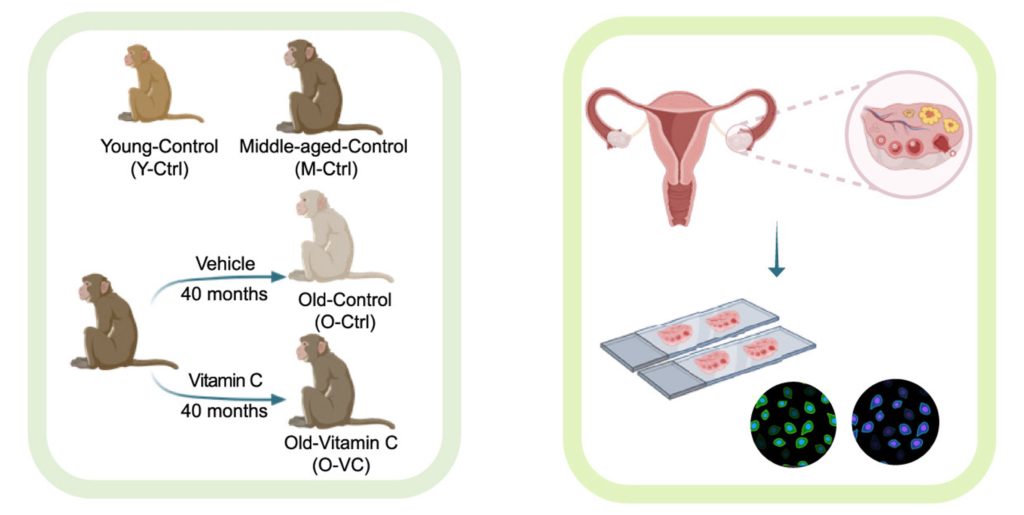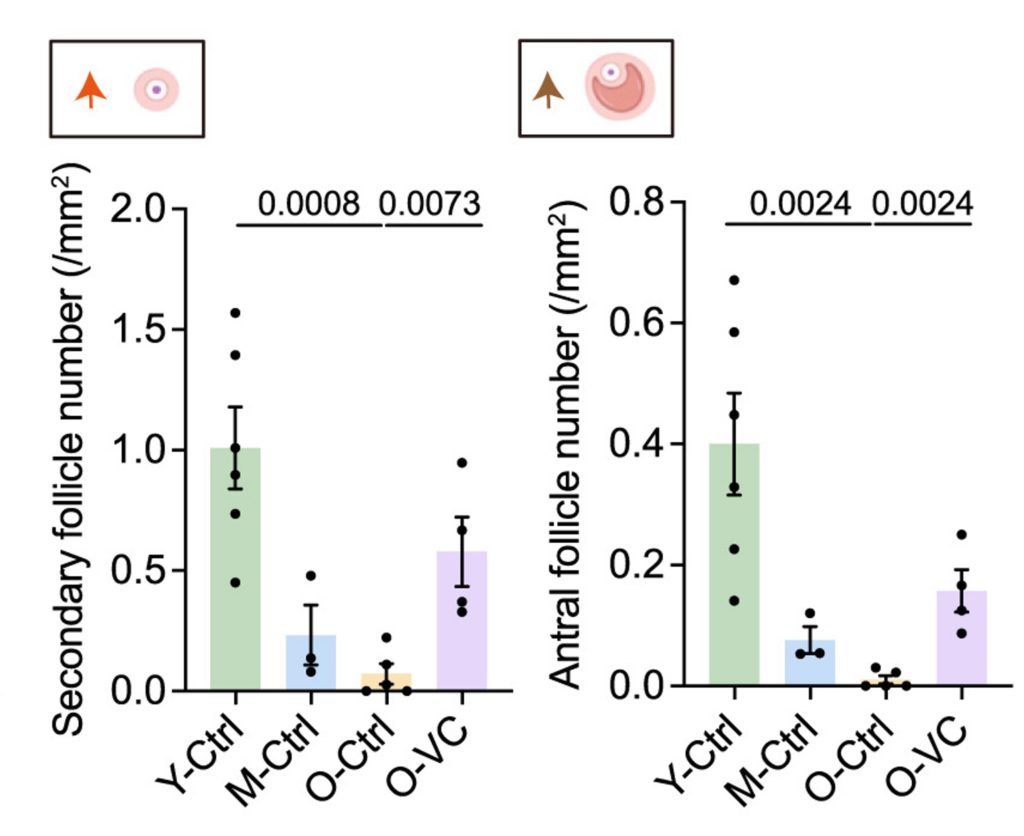Vitamin C Counteracts Reproductive Aging, New Study Shows
Long-term supplementation with vitamin C rejuvenates the ovaries of monkeys by counteracting several underlying biological drivers of aging, including age-promoting senescent cells.
Highlights
- Vitamin C supplementation rejuvenates the aging ovaries of monkeys, increasing indicators of fertility.
- The essential vitamin reduces the biological age of multiple cells found in the ovaries, including oocytes.
- Vitamin C contributes to the elimination of age-promoting senescent cells while combating several other biological drivers of aging.
Scientists are quickly gaining an understanding of how aging is modulated at the cellular level. So far, they have identified multiple drivers of biological aging, known as the hallmarks of aging, which encompass chronic inflammation, DNA mutations, and mitochondrial dysfunction. In the longevity field, the pièce de resistance is a compound that can counteract as many hallmarks of aging as possible. Such a geroprotective compound would ideally lead to an extension in lifespan while delaying age-related processes, such as menopause.
Surprisingly, in a new study, researchers in China and Altos Labs in California have found that a familiar compound, vitamin C, counteracts multiple hallmarks of aging. In the study, it was shown that vitamin C supplementation rejuvenates the aging ovaries of female monkeys. Still, the beauty of geroprotective compounds is that they target cells, meaning their effects can apply to nearly all organs and tissues. This means that vitamin C could potentially do more than counteract reproductive aging.
The Consequences of Reproductive Aging
With age, sex hormone levels tend to decline: testosterone levels drop in men, while estrogen and progesterone levels decrease in women. Such blunted sex hormone levels can induce aging hallmarks like inflammation and oxidative stress—damage caused to cells by excessive levels of reactive oxygen species (ROS). By definition, this acceleration in cellular aging is associated with a higher likelihood of early mortality and chronic diseases.

Recently, the U.S. Department of Health and Human Services announced the removal of warning labels from hormone replacement therapy (HRT) products for menopause, citing a lack of robust scientific evidence. Indeed, high-quality studies have shown that initiating HRT within 10 years of menopause onset reduces the risk of all-cause mortality. HRT may also reduce the risk of heart disease by up to 50%, Alzheimer’s disease by 35%, and bone fractures by up to 60%. It follows that counteracting reproductive aging may lead to a longer life without disease.
Comparing Monkeys to Monkeys on Vitamin C
While HRT may mitigate the age-accelerating effects of declining hormone levels, other geroprotective compounds may prove beneficial as well. The hallmarks of aging are highly interrelated, and targeting one can influence the others. For example, dysfunctional mitochondria are known to inadvertently generate excessive levels of ROS, which can induce oxidative stress. In turn, oxidative stress can trigger DNA mutations, telomere shortening, inflammation, and further mitochondrial damage.
With this interconnectedness in mind, the China-based researchers tested the effects of vitamin C on reproductive aging. Vitamin C is a powerful antioxidant: a molecule capable of neutralizing ROS and stopping oxidative stress. Like us, and unlike rodents, monkeys are unable to produce vitamin C on their own. Thus, the researchers chose to study cynomolgus macaques (Macaca fascicularis). These female monkeys were 12 to 16 years old, roughly equivalent to 40 to 53 human years, an age range nearing the onset of menopause.

As with many well-designed studies of aging, the older (12- to 16-year-old) monkeys were compared to young (4-year-old) monkeys, roughly equivalent to 13 human years. This is because the goal of any geroprotective compound is to elicit rejuvenation, and the measurements taken from the young monkeys represent what a fully rejuvenated monkey would look like. And if young monkeys were not enough, the older monkeys were also compared to middle-aged (11- to 12-year-old) monkeys, roughly equivalent to 33 to 40 human years. In this way, different levels of rejuvenation could be assessed.
Vitamin C Partially Rejuvenates Aging Ovaries
Perhaps expectably, vitamin C supplementation increased antioxidant proteins in the ovaries of older monkeys. Correspondingly, vitamin C reduced oxidative stress, as measured by reduced oxidative damage to DNA and fats. Crucially, vitamin C supplementation also mitigated age-related follicular depletion—the gradual loss of ovarian follicles that occurs with aging. These follicles are fluid-filled sacs containing oocytes (eggs) that mature during menstruation and rupture upon ovulation (the release of the egg). A higher number of follicles, particularly mature follicles called antral follicles, is an indicator of fertility.

Vitamin C Reduces Biological Age
Our genes determine how our bodies function, providing a sneak peek into the underlying code that determines our physical existence. At any given moment, thousands of genes are turning on or off, modulating how our cells, tissues, and organs operate. However, as time passes, genes that were once turned off turn on, and genes once turned on shut off. These changes provide a genetic signature that can be used to estimate the biological age of said cells, tissues, and organs, which is precisely what the China-based researchers did.
By measuring the genetic signatures of single cells, the researchers found that vitamin C reduced the biological age of several cell types found within the ovaries of older monkeys. Notably, the biological age of oocytes, the largest human cell type, was reduced by 1.35 years. Still, it was the non-reproductive cells—somatic cells—that showed the greatest reduction in biological age. Namely, the average biological age of all somatic cells within the ovaries was reduced by a remarkable 5.66 years. Interestingly, the biological age of endothelial cells, the cells that line our blood vessels, was reduced by 6.99 years.

Vitamin C Eliminates Senescent Cells
In addition to oxidative stress, vitamin C was shown to combat multiple hallmarks of aging, including mitochondrial dysfunction, inflammation, and DNA damage. The essential vitamin also combated one of the more recently discovered hallmarks: senescent cells. As mentioned earlier, the hallmarks of aging are highly interrelated, and senescent cells are no exception. In response to DNA damage, inflammation, and other cellular stressors, our everyday cells enter a state of senescence, becoming senescent cells.
Senescent cells are thought to accumulate with age due to age-related deficits in immune system function. The problem is that senescent cells send out chemical signals, including inflammatory molecules, that contribute to chronic inflammation, another hallmark of aging. Removing senescent cells with compounds called senolytics has been shown to prolong lifespan and ameliorate chronic diseases in animal models, suggesting that removing these age-promoting cells benefits health and longevity.

Is Vitamin C a Geroprotective Compound?
The study suggests that vitamin C is a geroprotective compound, since it can target and, at least partially, prevent the development of several hallmarks of aging. The authors of the study note that vitamin C,
“Has demonstrated therapeutic potential in a range of conditions, including mental disorders (e.g., major depressive disorder, schizophrenia, anxiety, and Alzheimer’s disease) and cardiovascular diseases (e.g., hypertension, atherosclerosis, myocardial ischemia, and heart failure).”
Thus, it is possible that this potent antioxidant can lead to the alleviation of aging hallmarks in multiple organs. However, there is a lack of human data to back this up. More human studies are needed to determine which conditions warrant supraphysiological doses of vitamin C.
Model: Middle-aged (12- to 16-year-old) female cynomolgus macaques (Macaca fascicularis)
Dosage: 30 mg/kg/day of vitamin C for 40 months

